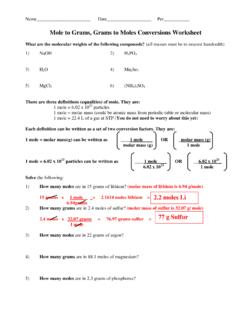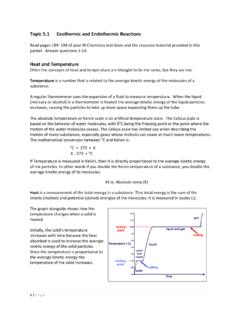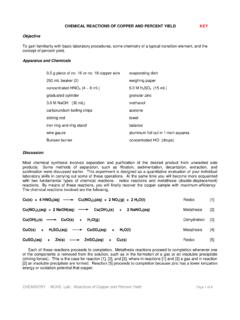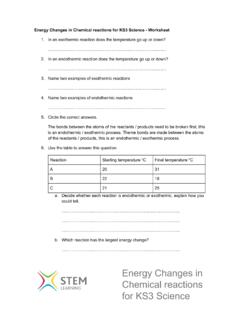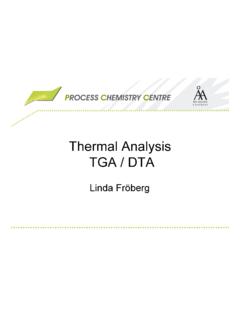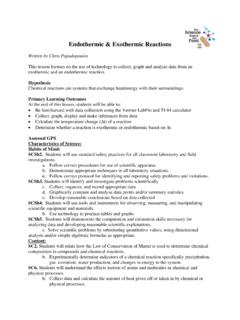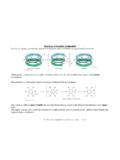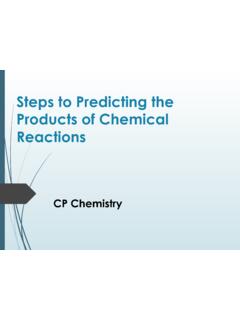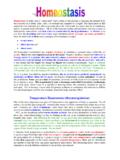Transcription of Chapter 10 – Chemical Reactions Notes
1 Chapter 8 Chemical Reactions Notes Chemical Reactions : Chemical Reactions are processes in which the atoms of one or more substances are rearranged to form different Chemical compounds. How to tell if a Chemical reaction has occurred (recap): Temperature changes that can t be accounted for. o Exothermic Reactions give off energy (as in fire). o endothermic Reactions absorb energy (as in a cold pack). Spontaneous color change. o This happens when things rust, when they rot, and when they burn. Appearance of a solid when two liquids are mixed. o This solid is called a precipitate. Formation of a gas / bubbling, as when vinegar and baking soda are mixed. Overall, the most important thing to remember is that a Chemical reaction produces a whole new Chemical compound. Just changing the way that something looks (breaking, melting, dissolving, etc) isn t enough to qualify something as a Chemical reaction! Balancing Equations Notes : Things to keep in mind when looking at the recipes for Chemical Reactions : 1) The stuff before the arrow is referred to as the reactants or reagents , and the stuff after the arrow is called the products.
2 2) The number of atoms of each element is the same on both sides of the arrow. Even though there may be different numbers of molecules, the number of atoms of each element needs to remain the same to obey the law of conservation of mass. 3) The numbers in front of the formulas tell you how many molecules or moles of each Chemical are involved in the reaction. 4) Equations are nothing more than Chemical recipes. How to balance equations: When working on Chemical recipes, it s important to figure out how much stuff we ll need to make the stuff we need, and it s important to figure out how much stuff we ll make. To make this work, we take the ingredients and products and generate a list of how many of each we ll need. This is called balancing equations , and it ensures that we obey the law of conservation of mass. How to do this: 1) Draw boxes around the molecular formulas of the ingredients. Never change anything inside the boxes, EVER! Reason: You can t change the formulas of the compounds that you re working with, or you ll mess up the recipe!
3 Example: NaCl + CaO MgO + CaCl2 2) Make a table that shows the number of atoms of each element before and after the arrow. Element Before After Na 1 1 Cl 1 2 Ca 1 1 O 1 1 3) Equations are balanced when both columns are the same, because that means that the amount of stuff you make is exactly the same as the amount of stuff you started with. To do this, put numbers in front of each box to multiply the number of atoms inside of it. How do you know what to put? You don t, but can make a guess based on the before and after columns. 2 NaCl + CaO Na2O + CaCl2 4) Any time you put a number in front of a box, redo the inventory by going back to step 2. If the two sides still aren t the same, change something else. 5) Keep adding numbers in front of boxes until the two columns in your inventory match. Then you re done! Handy tips: If you can t figure out the problem, start over! o There are a lot of steps and it s easy to make a mistake at first.
4 If you can t solve the equation because things are too weird, put a 2 in front of the most complicated looking molecule and start over. o If this doesn t work, put a 3 there instead. If you can reduce coefficients, do it! Completing the Chemical Recipes Notes : So far, we ve seen how to list the ingredients for a Chemical recipe. However, as we already know, the ingredients aren t enough to figure out how to make something in the kitchen. In addition, you also need to figure out how you need to prepare the ingredients into the desired product. In chemistry, these are referred to as reaction conditions. How to indicate reaction conditions: 1) Symbols of state: These tell you whether something is a solid, a liquid, a gas, or dissolved in water: Symbol What it means (s) solid (l) liquid (g) gas (aq) dissolved in water (aqueous) Example: 1 PbCl4aq) + 2 Ca(OH)2 2 CaCl2(s) + 1 Pb(OH)4(s) 2) Symbols used around the arrow tell you what conditions you need to meet for the reaction to occur: Symbol What it means add lots of heat 1000 (or any temp) carry out the reaction at exactly this temperature.
5 Equilibrium [anything else] do whatever it says v Example: C6H12(l) + 9 O2(g) 6 CO2(g) + 6 H2O(g) 3) H after the equation indicates the amount of energy that is absorbed or given off during a reaction. If H is positive, it s an endothermic reaction, which means it absorbs energy and feels cold. If H is negative, it s an exothermic reaction, which means it gives off energy and gets hot. c Example: 2 H2(g) + O2(g) 2 H2O(g) H = -572 kJ/mol 6 Types of Chemical Reaction Notes (show Reactions when doing): 1) Combustion reaction: Oxygen combines with a hydrocarbon (something that contains carbon and hydrogen, plus maybe other elements) to form carbon dioxide, water, and heat. General: something + O2(g) CO2(g) + H2O(g) H = - Example: 2 C2H6O(g) + 7 O2(g) 4 CO2(g) + 6 H2O(g) 2) Synthesis reaction: Two or more simple molecules combine to make a complicated one: General: A + B AB Example: 2 Mg(s) + O2(s) 2 MgO(s) 3) Decomposition reaction: The opposite of a synthesis when a complex molecule breaks down to make several simpler ones.
6 General: AB B + A Example: H2CO3(aq) H2O(l) + CO2(g) 4) Single replacement / displacement reaction: An element switches places with another element in a Chemical compound. General: A + BC AC + B Example: Cu(s) + AgNO3(aq) CuNO3(aq) + Ag(s) 5) Double replacement / displacement reaction: The cations of two ionic compounds switch places. General: AB + CD AD + CB Example: ZnI2(aq) + Pb(NO3)2(aq) Zn(NO3)2(aq) + PbI2(s) 6) Acid-base reaction: A double replacement reaction in which water is formed. General: HA + BOH BA + H2O Example: Ca(OH)2(s) + 2 HCl(aq) CaCl2(aq) + H2O(l) The following is a handy series of questions that will allow you to determine the type of reaction that is taking place. To use this, keep going until the answer is yes , then STOP! Note: It s very important that you start from the beginning, or you might get the wrong answer! 1) Does your equation contain oxygen, carbon dioxide, AND water? If so, it s a combustion reaction.
7 2) Do simple molecules make complex ones? If so, it s a synthesis reaction. 3) Do complex molecules make simple ones? If so, it s a decomposition reaction. 4) Are any elements present by themselves? If so, it s a single replacement reaction. 5) Is water formed? YES Acid-base reaction. NO Double replacement reaction. Honors Only: Predicting Reaction Products Notes It s frequently handy to know what will be formed when two chemicals are put together. After all, the whole point of chemistry is to produce useful chemicals for various purposes, and it doesn t do us much good if we can t figure out how to do it. The big question: How do we figure out the products of a reaction? The answer: It depends on the type of reaction that s taking place. Combustion Reactions : Identification: Whenever you see CxHy reacting with O2. Products: CO2, H2O, and heat. (Example) Synthesis Reactions : Identification: If two elements or VERY simple molecules are reacting with each other, it s probably a synthesis reaction.
8 O Elements usually combine to form ionic compounds. (Example) o Simple covalent molecules usually combine to form more complex covalent molecules (Example) Products: o If an ionic compound will be formed, wing it based on the possible products. (Examples) o If a covalent compound is formed, it ll usually be something that you ve seen before. (Examples) Decomposition Reactions : Identification: If one compound has an arrow coming off of it, it s decomposing. Products: The products will be either simple covalent molecules (water, CO2, O2, N2, etc) or the constituent elements (if you can t figure out what simple molecules might be present). o Show examples of each. Single replacement Reactions : Identification: A single element (either a metal or halogen) reacts with. Coming up with products at this point should be simple. The big question: Will a reaction take place at all? o Look at the activity series on p. 288 of the book. If the lone element is higher than the element that it s trying to replace, the reaction will proceed.
9 Otherwise, it will not. o Examples: Li + NaOH LiOH + Na reaction will occur. Zn + Ca(OH)2 Zn(OH)2 + Ca will not occur. Double replacement Reactions : Identification: Two ionic compounds react with each other. Products: o Acid-base: If one of the compounds is an acid and the other contains OH , it s an acid-base reaction the products will include water and a salt. o Double replacement: Like with single replacement Reactions , these sometimes will occur and sometimes won t. Why? For these Reactions to occur, both of the reactants must be soluble in water. However, for the reaction to do anything, one of the products must form a precipitate ( it must not be soluble in water). Let s see why: NaCl + NH4OH NaOH + NH4Cl (or, at least it would seem) In reality, all of these compounds are soluble in water, so the reaction would actually be: Na+(aq) + Cl-(aq) + NH4+(aq) + OH-1(aq) Na+(aq) + OH-1(aq) + NH4+(aq) + Cl-(aq) Which is exactly the same on both sides.
10 The only way we can get around this is to have one of our products be insoluble in water. Our big question: How do we know if one of our products will be soluble in water? o Look at a solubility table. Check both expected products and see which (if either) will actually be made. o Have them do a big example: MgCl2 + NaOH ? Go through how to solve to get: MgCl2(aq) + 2 NaOH (aq) Mg(OH)2(s) + 2 NaCl(aq) This, of course, sets up another couple of terms for us to learn. Chemical (or molecular ) equation: The thing we drew above. Complete ionic equation: When we show the equation in ways that reflect how the compound really looks: Mg+2(aq) + 2 Cl-1(aq) + 2 Na+(aq) + 2 OH-(aq) Mg(OH)2(s) + 2 Na+(aq) + 2 Cl-1(aq) Net ionic equation: When we only show the ions that actually combine to form our product. o The ions that don t form product are referred to as spectator ions, since they don t change over the course of the reaction. Mg+2(aq) + 2 OH-(aq) Mg(OH)2(s) Additional in-class exercises: Write the complete ionic equation and net ionic equation for the following Reactions : AgNO3 + AlCl3 K3PO4 + Ba(OH)2
